September 3, 2021
The 2021 TUFS Japan-Russia Summer School was successfully conducted for two weeks, starting on the 23rd of August. As in 2020, it was conducted online in order to avoid contributing to the spreading of the corona virus, and featured such activities as tandem learning, international Japanese studies, and a subtitling workshop. The program received high marks from the students who participated in it.
The Program
- Date: August 23, 2021 to September 3, 2021
- Time: 16:00 ~ 17:30 or 19:00 (Japan time)
- Schedule:
8/23(Mon.)- Orientation, including a presentation in English on how to do tandem learning
8/24(Tue.)- Tandem Learning – self-introductions
8/25(Wed.)- International Japanese studies – Lecture in Russian on current Japanese literature
8/26(Thur.)- Tandem Learning – Literature and Art
8/27(Fri.)- International Japanese Studies – Video in Japanese and Russian on how to improve one’s qualities as a job candidate
8/30(Mon.)- Tandem Learning – Work and Employment
8/31(Tue.)- International Japanese Studies – Virtual Tour of Tokyo in Russian
9/01(Wed.)- Tandem Learning – Tourism
9/02(Thur.)- Subtitling workshop (Russian to Japanese)
9/03(Fri.)- Subtitling workshop (Japanese to Russian)
Reflections from participants from Japanese universities and from TUFS’s partner universities in Russia
(Japan) 23 participants from 3 universities
・TUFS – 19 participants (19 registered, 9 unregistered)
・Kobe City University of Foreign Studies – 3 participants
・Sophia University – 1 participant
(Students were recruited from other universities due to an insufficient number of participants from TUFS)
(Russia)23 participants from 6 universities in Russia
・Lomonosov Moscow State University – 4 participants
・Moscow State Institute of International Relations – 3 participants
・Russian State University for the Humanities – 4 participants
・Higher School of Economics – 4 participants
・Saint Petersburg State University – 4 participants
・Far Eastern Federal University – 4 participants
Presentation:INTRODUCTION TO TANDEM LEARNING
On the first day, Benjamin Larson, an American PhD student at TUFS who specializes in tandem learning, gave a presentation similar to the one he gave last year for the participants on how to engage in tandem learning.
Benjamin Larson introducing the participants to the fundamentals of tandem learning
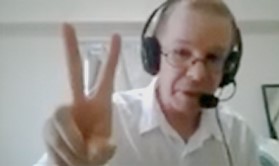
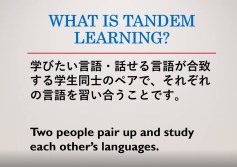
Daily schedule for tandem learning
Each tandem learning session was organized according to a schedule like the one shown here:
① Conversation in Russian (20 min.)
② Conversation in Japanese (20 min.)
③ Participants write essays in their target languages based on the conversations (30 min.)
④ Participants correct each other’s essays (15 min.)
⑤ Participants read their essays out loud, and correct each other’s pronunciation (15 min.)
⑥ Participants present their essays in groups of 4~6 (15 min.)
⑦ Participants upload their essays and a recording of them reading them to a Google Form for assessment
Session photographs (Some participants)
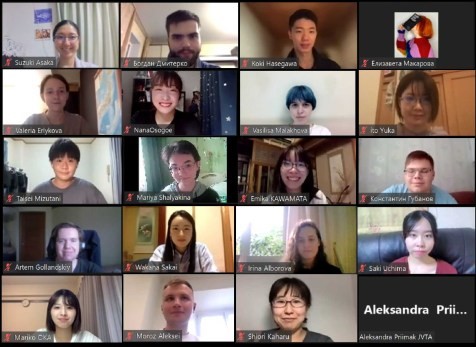
(Student impressions)
・I had the opportunity to understand Russian as spoken by Japanese people, and I learned about how complicated Russian can be. In addition, I lost some of the embarrassment I feel expressing myself in Japanese. Although there are many things I still cannot say, I felt encouraged to study more, and I was able to make many Japanese friends. (Russian student)
・I came to feel that tandem learning is a really good method for studying a foreign language, because one can simultaneously improve one’s skills at speaking, listening, and writing while also making friends. Moreover, it has advantages over classroom learning in that one can ask questions without feeling embarrassed, and one can learn without being hindered by a fear of making mistakes. (Japanese student)
International Japan Studies
The Summer School included three International Japanese Studies classes, which were primarily taught in Russian, which made it easier for the Russian students to understand the course contents accurately. For TUFS students who attended it was not necessarily easy for them to follow Russian spoken at a regular speed for a native speaker, however, it was an opportunity for them to listen to a lecture given in their target language (Russian), to assess their own listening abilities, and to acquire vocabulary and expressions that would be useful to them in explaining aspects of Japan in Russian.
(1)Japanese Literature Today (16:00 – 17:30, August 25, 2021)
Lecturer: Maria Prokhorova, a PhD student at TUFS studying Japanese literature
Overview: In Russia, the number of Japanese authors who have attained popularity in Russia is not very great, however popular authors do include Murakami Haruki, Yoshimoto Banana, Murakami Ryu, and Suzuki Koji. The works of Murakami Haruki are often utilized as curriculum materials for students of Japanese because Murakami was heavily influenced by both western literature and his own activities in translation, and as such his novels often utilize language forms which are readily accessible to speakers of western languages. Some of the notable differences between Russian literature and Japanese literature is that Japanese literature displays less reverence for classical styles, the division between “pure” literature and “popular” literature is more vague, and whereas Russian literature primarily focuses on themes of the past or the future, Japanese literature tends to focus on the present. Moreover, Japanese readers tend to favor Japanese literature over foreign literature.
Maria Prokhorova lecturing
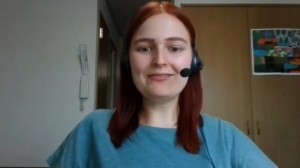
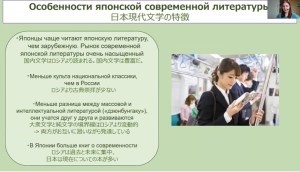
(Student impressions)
・From Maria, I learned about authors I had never heard of before. (Russian student)
・This was a very interesting presentation; there were a number of authors and works that I had never heard of before. I was particularly interested to hear about Tawada Yoko, who graduated from Waseda University‘s department of Russian literature, and who is currently engaged in very global activities. I really felt that I would like to read her work sometime. (Japanese student)
(2)Shugyo Noryoku Yosei Kyozai Doga (Video-Tutorials on Developing one’s Employability)(16:00 – 17:30, August 27, 2021)
Participants watched one or more of three videos in the series Shugyo Noryoku Yosei Kyozai Doga (Video-Tutorials on Developing one’s Employability) produced by Hosei University, learned about the good points of the Japanese working style, and the following day discussed with their tandem partner. Each video features subtitles in Russian and Japanese which were produced at TUFS. It was a very useful opportunity for both Russian students and Japanese students to acquaint themselves with business Japanese and business Russian. Below are the titles of each video.
① Umi o wataru yume (A Dream that crosses the sea)(26 minutes)
A young employee at a toy manufacturer is assigned to an overseas expansion project, and comes to understand the importance of teamwork and of market research.
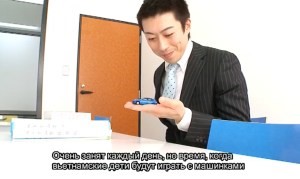
② SE ga Tsukuru Mirai (The Future that an SE Creates)(31minutes)
A systems engineer (SE) is working on automation of the production processes at sake breweries, and learns that to be successful, one must both have a thorough understanding of the customer’s needs and ensure that the process is comprehensively systematic.
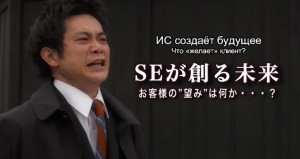
③ Todokeru Chikara (The Power to Deliver) (16 minutes)
Employees at a major airline must work together to carry out a detailed survey regarding the new air-freight route their company is developing to determine, among other things, whether it will profitable.
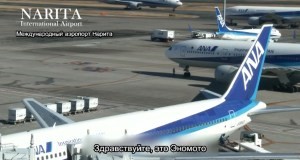
(Student impressions)
・I had the opportunity to learn about people who work at Japanese companies, and to learn Japanese phrases which will be useful in business, as well as how one acts at a Japanese company. Moreover, I had the opportunity to learn about how business is conducted at large Japanese companies. (Russian student)
・Ultimately, the study of language is a tool for which allows nothing more than for one to express their own thoughts. Thus, to successfully understand what an associate or potential business partner wants, one must first have one’s own opinions. This is true regardless of whether that associate is Japanese or foreign. (Japanese student)
(3)Online Tour of New and Old Sites in Tokyo (16:00 – 17:30, August 31, 2021)
Mr. Denis Morozov, Section Chief for Inbound Travel at JIC Travel Center Co., Ltd. served as guide.
Overview: Students participated in a hybrid online tour of Tokyo which involved both real-time video of Asakusa neighborhood and a 40-minute video produced by Mr. Morozov entitled Tokyo no Shinkyu Meisho (Old and New Sites in Tokyo). Replete with witticisms and humor, Mr. Morozov’s video introduced students to sightseeing spots in Nihonbashi, Ginza, Mesm Tokyo Hotel in Takeshiba, Hama-rikyu Garden, Nezu Shrine, Shinjuku Golden Gai, and Shibuya Sky.
Denis Morozov acting as guide
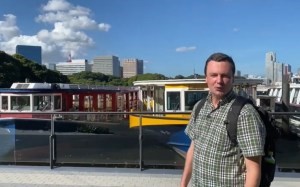
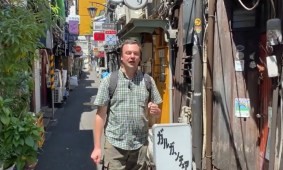
(Student impressions)
・Thanks to Mr. Morozov, I was able to learn new things about places I had visited. I felt a strong desire to visit Tokyo. (Russian student)
・It was very interesting to learn about what it was like to live in Edo-era Japan by learning about such areas as Asakusa and Nihonbashi. The tour also included information about the Tokyo Olympics and about Mitsui Takatoshi; it felt like we were retracing the history of Tokyo from the medieval era to the modern day. I had in fact never heard of Hama-rikyu Garden or Nezu Shrine before, so as a Japanese person it was a really interesting tour. (Japanese student)
Subtitle Translation
Japan Visualmedia Translation Academy conducted a subtitle translation workshop similar to the workshop they conducted last year.
(1)Subtitle Translation Workshop (Russian to Japanese) (16:00 – 19:00, September 2, 2021)
Overview: There are three important rules to keep in mind when creating Japanese subtitles: 1.) the limit is four characters per second of video, 2.) 14 characters should fit on two lines, 3.) do not use punctuation marks; substitute a full space for periods, and a half-space for commas.
(2)Subtitle Translation Workshop (Japanese to Russian) (16:00-19:00, September 3, 2021)
Overview: When creating Russian subtitles, there are six important rules to keep in mind: 1.) The limit is 15 letters per second of video, 2.) 40 letters should fit on two lines, 3.) one should use ё as well as “e” 4.) Russian quotation marks are permitted, 5.) quotation marks and interjections that Russian speakers would understand should not be used, 6.) proper nouns should be rendered using the Polivanov system for Cyrillization of Japanese.
Students divided themselves into the same groups as yesterday, and took on the challenge of creating Russian subtitles for Japanese television dramas and anime.
(Student Impressions)
・This was an opportunity for me to learn the rules for creating subtitles. I also learned about how to develop relationships with Japanese people. It really was a wonderful experience. (Russian student)
・Through this workshop I came to understand that creating subtitles is not just about translating the dialogue in the show, it is about successfully putting across to the audience the message that the show is trying to convey, which means the person creating the subtitles must have the professional skill necessary to overcome the language barrier. (Japanese student)
(Overall Impressions)
・This summer school was really quite interesting because it afforded me the opportunity to speak with native speakers of Japanese and to deepen my understanding of Japan. (Russian student)
・I would say the most rewarding part was the Japanese literature lecture and the pair work. This was not only an opportunity to improve my Japanese, but to better understand Japanese culture. (Russian student)
・I have had basically no opportunities to speak with Russian students one-on-one, so this was really a meaningful experience. I got to communicate with a Russian student outside of class, sharing impressions of the day’s class and such, using social media, which shows how our opportunities for interaction increased. We got to learn not just about academic topics, but also viewed videos, attended lectures, and participated in workshops where we learned about topics related to the business world, which for someone like me who has basically been avoiding job-hunting was a really good opportunity to expand my horizons. (Japanese student)
